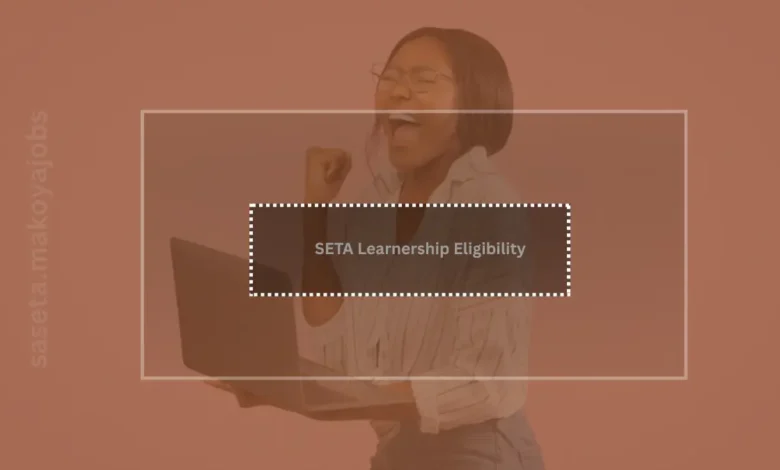SETA Learnership Eligibility: Age and Other Key Qualifiers for SETA Programmes

Learn about the age limits for SETA Learnership Eligibility in South Africa, including who qualifies, exceptions, and how to apply.
Understanding Age Limits for SETA Learnerships in South Africa
SETA (Sector Education and Training Authority) learnerships offer vital workplace training, national qualifications, and stipends. But a key question for many job seekers is: What is the age limit to qualify? This guide addresses that and explains eligibility essentials.
1. What Is a SETA Learnership?
A learnership combines theoretical training with practical workplace experience. These are accredited programmes that award a qualification on the National Qualifications Framework (NQF). Most run for 12 to 24 months, blending classroom learning with work-based modules. Learners typically receive a monthly stipend, though amounts vary by SETA and host employer.
2. What Is the Age Limit?
Typical Age Range: 18–35 Years
Most SETA learnerships are open to South African citizens between 18 and 35 years old. This range ensures the target group—youth and recently unemployed individuals—receives priority access.
Exceptions in Certain Cases
Some learnerships may accommodate older applicants beyond 35, especially for upskilling within employed roles or specific skills gaps. For certain trades or sector-specific programmes, a lower age minimum (such as 16 or 17) may apply.
3. Why This Age Range Exists
Youth empowerment is a primary goal of SETAs under the National Skills Development Strategy. Age limits ensure funding and programme access are directed toward unemployed or starting-career individuals. Special allowances sometimes exist for employed learners or older individuals based on unique priorities within certain SETAs.
4. Additional Eligibility Requirements
To apply for a SETA learnership, applicants generally must:
- Be a South African citizen or permanent resident
- Hold at least a Grade 12 (Matric, NQF Level 4) or relevant lower-level qualification depending on the programme
- Be currently unemployed, or employed individuals must be sponsored by an employer
- Not be enrolled in another learnership or full-time education programme
- Ensure a clear criminal record and any required medical assessments
- Show motivation and willingness to complete the full programme duration (12–24 months)
5. How Age Rules Vary by SETA or Programme
Different SETAs manage learnerships across sectors—like MICTSETA (IT), MERSETA (engineering), HWSETA (health and welfare), and others. Slight variations may apply:
- Some technical or trade learnerships may begin with candidates aged 16 or 17.
- Upskilling programmes for employed workers or later-career roles sometimes apply to 40+ applicants—though these are rare and case-specific.
6. What Happens If You’re Outside the Age Gap?
If you’re older than 35:
- You may be prioritized lower for youth-focused programmes.
- Some SETAs may allow participation if you are employed by a sponsoring employer or enrolling in upskilling courses.
- Always check individual SETA guidelines or directly inquire to clarify inclusion.
If you’re younger than 18:
- Opportunities may be very limited—most require completion of Grade 12 before entry.
- Short-term trainee programmes or ABET initiatives may offer better entry points.
7. What to Do If You’re Uncertain
- Visit your relevant SETA’s website or contact learner support teams for guidance on age allowances.
- Register at your local Labour Centre to be notified of programmes matching your profile.
- Apply early and prepare all required documentation (ID, Matric certificate, proof of residence, CV).
- Always apply for multiple programmes to increase your chances.
8. Testimonials and Insights
Many applicants between 18 and 35 find SETA learnerships to be a valuable entry point into employment. Learnerships offer both nationally recognised qualifications and practical job experience—something many young professionals lack at the start of their careers.
9. What You’ll Gain When You Qualify
- Accredited qualification aligned with national standards
- Hands-on work experience in your sector
- Monthly stipend to support living costs during training
- Improved employability—some employers hire learners upon completion
- Networking potential with employers and industry contacts
10. Summary: Is Your Age Within the SETA Learnership Limit?
| Age Range | Eligibility Likely? |
|---|---|
| 16–17 years | Rare exceptions for trade programmes |
| 18–35 years | Fully eligible for most SETA learnerships |
| 36–40 years | Limited – some upskilling or internally sponsored programs |
| Above 40 | Unlikely for youth learnerships—explore alternate training or bursaries |
Final Thoughts
SETA learnerships are accessible primarily to South Africans aged 18 to 35 who hold at least a Grade 12 certificate and seek structured workplace training. While some exceptions exist—especially for trade or upskilling programmes—the norm focuses on youth employment and foundational skill-building.
If you fall within the core age group, prepare your documentation, register with relevant SETAs or Labour Centres, and apply early. And if you’re slightly outside the range, explore whether your SETA allows special consideration or whether similar programmes (like bursaries or trainee initiatives) are available.





